Piazza Navona in Rome: What is It? History, Fountains & Location
Learn everything about Piazza Navona in Rome: how long to spend there, how far it from from trevi fountain and what to see
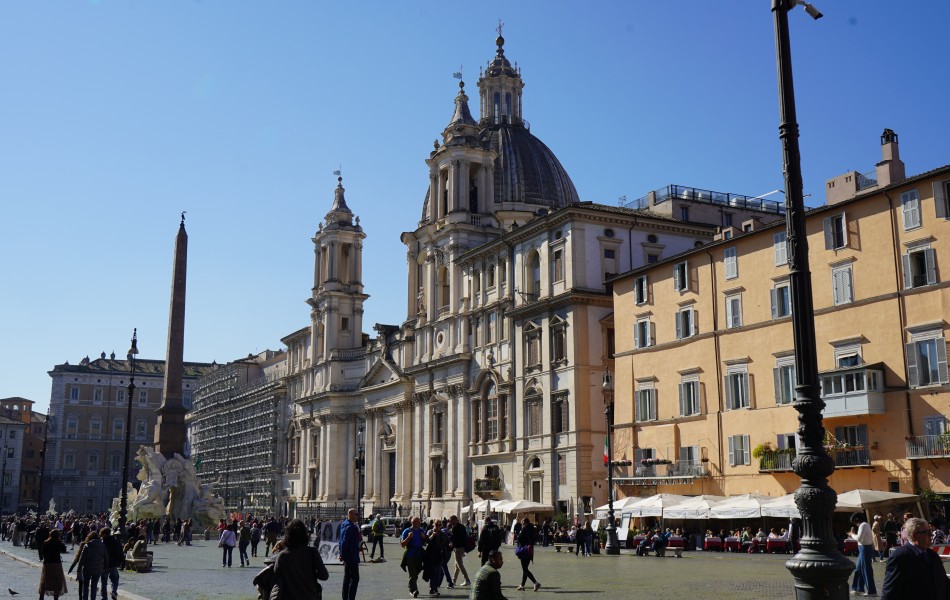
25 March 2025
Rome Travel GuidePiazza Navona is one of the most iconic and picturesque squares in Rome, a masterpiece of Baroque architecture and urban design that has enchanted visitors for centuries. Originally built on the site of the ancient Stadium of Domitian, this remarkable piazza has evolved from a sports arena into one of the city’s most vibrant and beautiful public spaces. If you want to visit the ancient stadium of Domitian book with us our Piazza Navona Underground Tour. Today, Piazza Navona is famous for its lively atmosphere, stunning fountains, historical significance, and cultural events that take place throughout the year. It's a symbol of Rome's ability to mix ancient history with artistic grandeur and modern life, in this travel guide you will find the answer to any of your questions.
What Is Piazza Navona and What to See Today
So, what exactly is Piazza Navona? In essence, it’s one of the most iconic and historically rich squares in Rome, built over the ruins of the ancient Stadium of Domitian. This vast stadium, commissioned in the 1st century AD by Emperor Domitian, was designed to host athletic competitions known as agones, as well as gladiator fights, mock naval battles, and public spectacles. It could accommodate up to 30,000 spectators and was a symbol of imperial grandeur and Roman entertainment culture. The elongated, oval shape of Piazza Navona perfectly preserves the footprint of this once-spectacular venue, allowing visitors to trace the contours of ancient Roman leisure with every step they take.
By the Middle Ages, the remains of the stadium had been partially buried and transformed into a bustling public space. In the 15th century, it officially became a city market, where vendors and artisans would gather, and where public festivities and celebrations took place. But it was in the 17th century that Piazza Navona reached its peak of beauty and fame, thanks to the vision of Pope Innocent X and the influence of the powerful Pamphili family. They transformed this historic space into an architectural masterpiece by commissioning artists like Gian Lorenzo Bernini and Francesco Borromini, who created some of the most beautiful fountains, palaces, and churches in the city.
What’s fascinating is that traces of the original Stadium of Domitian are still visible today. Visitors can descend beneath the piazza at the Stadio di Domiziano archaeological site, where the ancient walls, arches, and structures of the stadium have been excavated and opened to the public. This underground visit allows you to walk through ancient corridors and understand the scale and grandeur of the original complex, offering a unique connection between the living, breathing piazza above and the ancient Roman world below. In this way, Piazza Navona is not only a stage for Baroque elegance but also a rare place where the layers of Rome’s history — Imperial, Medieval, and Baroque — come together in one remarkable square.
Why Piazza Navona Is So Famous
What makes Piazza Navona truly famous is its unique blend of ancient history, Baroque grandeur, and vibrant Roman life. The square is renowned not only for its breathtaking collection of fountains and sculptures but also for the elegance of the palaces that frame it and its central role in the city’s cultural and social fabric. At the heart of its fame is the stunning Fountain of the Four Rivers, designed by the genius of Gian Lorenzo Bernini in 1651. This dramatic fountain features four monumental river gods, each representing one of the great rivers of the four known continents of the time: the Nile in Africa, the Ganges in Asia, the Danube in Europe, and the Rio de la Plata in the Americas. These figures are carved in dynamic poses around a towering ancient Egyptian obelisk, symbolizing the universality of papal authority and the reach of the Catholic Church across continents. The fountain’s intricate details, the flowing water, and the dramatic composition make it a perfect symbol of Roman Baroque art and a magnet for visitors from all over the world.
But the fame of Piazza Navona doesn’t end there. The square is also surrounded by other masterpieces, such as the Church of Sant'Agnese in Agone by Francesco Borromini and the elegant Palazzo Pamphilj, both adding to the piazza’s architectural harmony. Piazza Navona has long been a stage for daily Roman life: street artists set up their easels to paint portraits and landscapes, musicians perform for passersby, and children play by the fountains while locals and tourists alike relax at outdoor cafés. During the Christmas season, the square transforms into a festive market filled with lights, food stalls, decorations, and traditional toys, creating a magical atmosphere that draws visitors year after year.
All of these elements — artistic brilliance, historical depth, and lively Roman tradition — combine to make Piazza Navona not just a place to visit, but an unforgettable experience and one of the most famous and beloved squares in all of Italy.
What are the 3 Fountains in Piazza Navona?
The three fountains that define Piazza Navona are not only magnificent artistic masterpieces but also key elements that give the square its distinctive character and enduring allure. Together, these three fountains form an open-air museum of Renaissance and Baroque artistry, reflecting the creativity and talent of Rome’s greatest artists. They are not just decorative elements but storytelling masterpieces that represent power, mythology, and Rome’s relationship with nature and the world. Here's their description
The Fountain of the Four Rivers
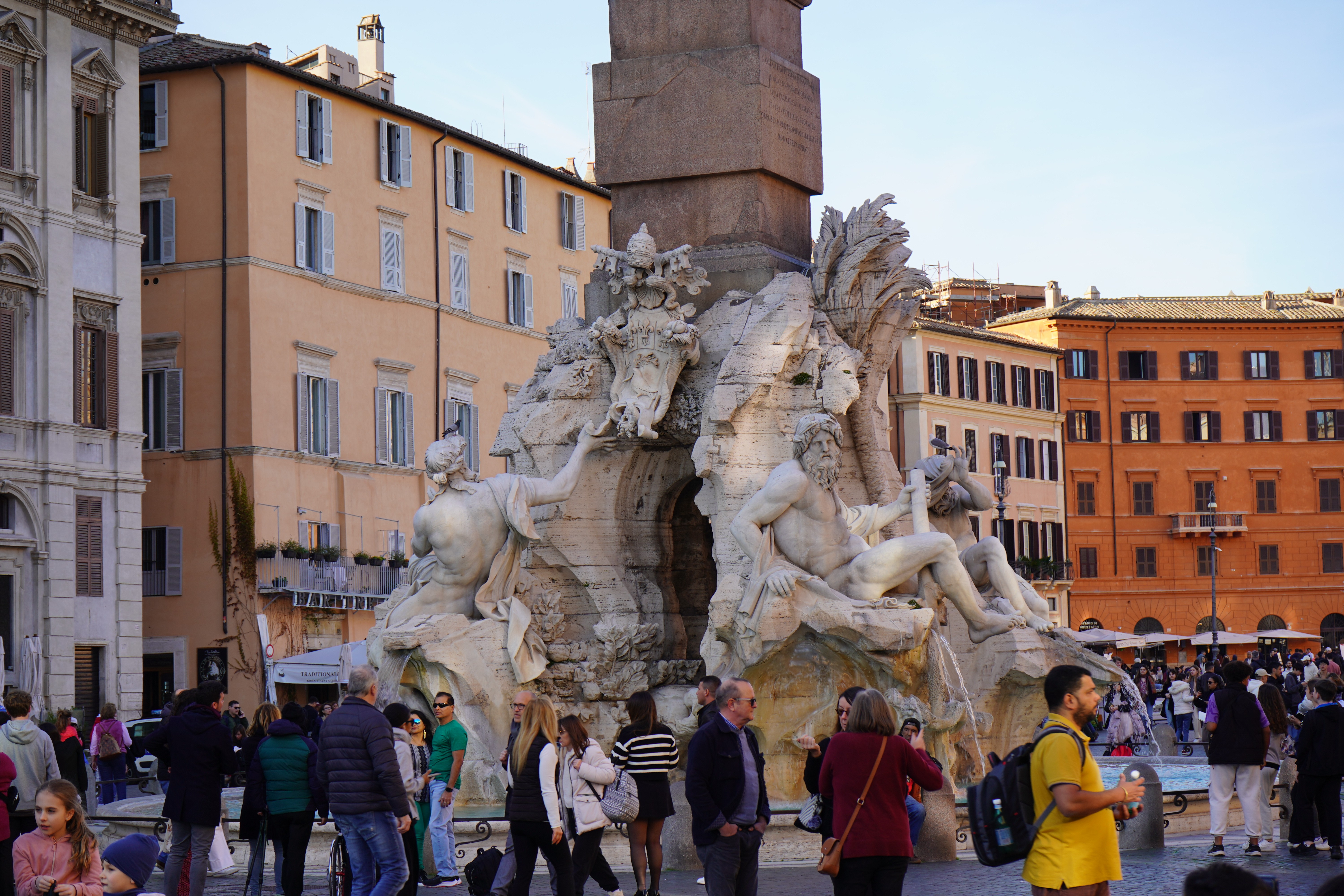
The Fountain of the Four Rivers (Fontana dei Quattro Fiumi) is undoubtedly the most iconic monument in Piazza Navona and one of the greatest triumphs of Baroque art in Rome. Commissioned by Pope Innocent X Pamphilj and masterfully designed by Gian Lorenzo Bernini, the fountain was completed in 1651 and remains a breathtaking example of sculpture, architecture, and symbolism combined into one theatrical masterpiece. At the heart of the fountain rises an ancient Egyptian obelisk, originally brought to Rome by Emperor Domitian, standing as a symbol of continuity between imperial Rome and the Church’s authority. The base of the fountain is an intricate composition of travertine rocks, exotic animals, and twisting flora, all animated by the ever-flowing water that gives the entire structure life and movement.
What truly sets the fountain apart are the four colossal river gods, each representing one of the great rivers of the known continents of the 17th century. The Nile, symbolizing Africa, is depicted with its head covered by a cloth, representing the then-unknown source of the river — a mystery that fascinated explorers for centuries. The Ganges, representing Asia, holds an oar, reflecting the river’s navigability and its vital role in trade and cultural exchange. The Danube, symbolizing Europe, touches the papal coat of arms carved into the rocks, a powerful reminder of the Church’s dominance over European affairs. Finally, the Rio de la Plata, representing the Americas, reclines on a pile of coins, alluding to the wealth and resources of the New World, but also appears startled, with an expression of awe and perhaps fear, reflecting the untamed and unfamiliar character Europeans associated with the American continent.
Beyond its artistic beauty, the Fountain of the Four Rivers was a bold political and religious statement. It celebrated the global power and spiritual reach of the Catholic Church during the Baroque era, transforming Piazza Navona into a stage that projected the Papacy’s supremacy over the known world. Bernini’s genius was not only in his technical ability to make marble and stone seem alive but also in his capacity to convey layers of meaning and grandeur that elevated the fountain beyond mere decoration.
Fountain of Neptune
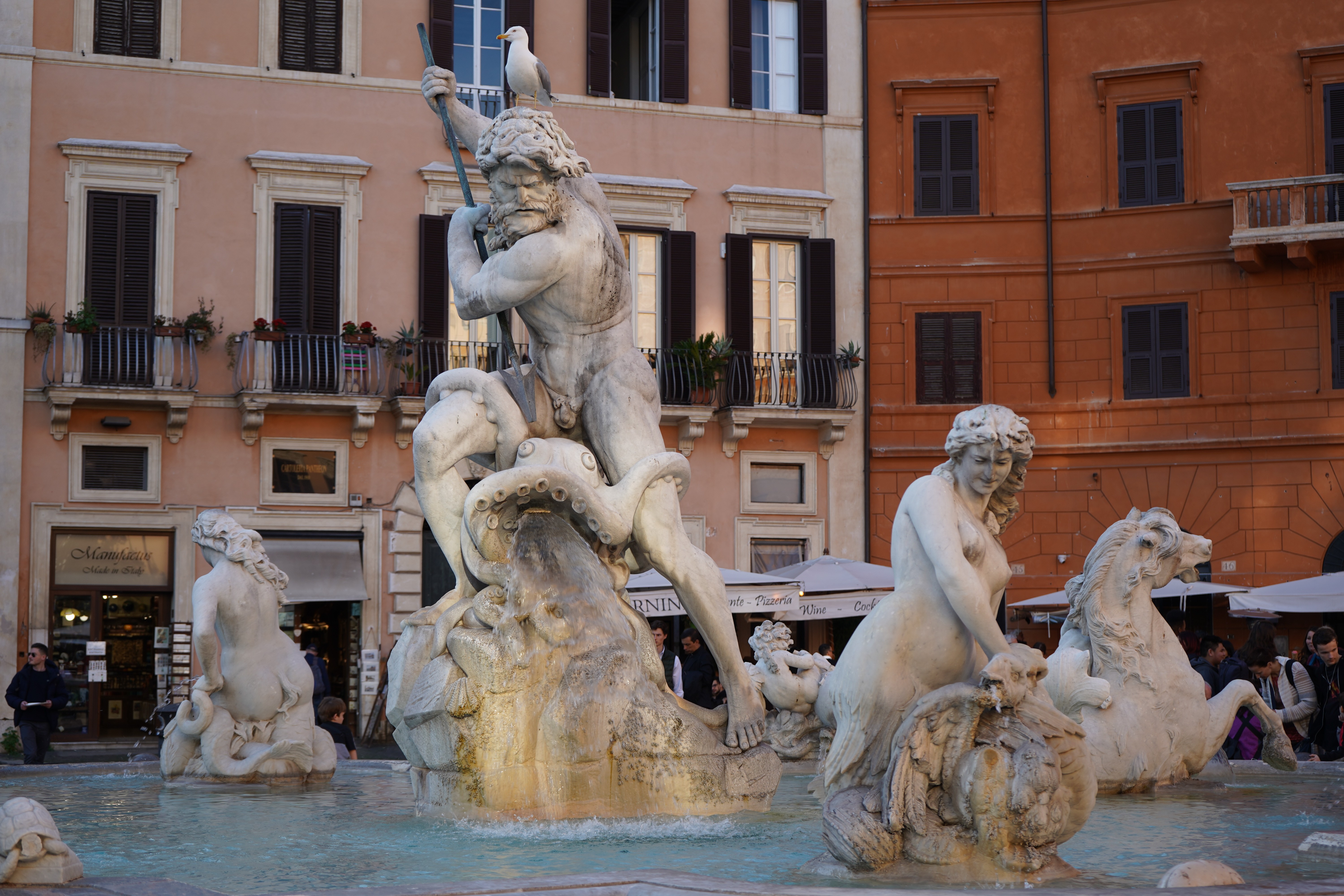
The Fountain of Neptune, located at the northern end of Piazza Navona, is another remarkable example of Rome’s rich artistic heritage and the evolution of Baroque public art. Originally designed in 1574 by Giacomo della Porta, one of the most prolific architects and fountain designers of the Renaissance period, the fountain initially lacked the grand sculptural decorations that adorn it today. For centuries, it remained a more modest, functional fountain, serving the surrounding neighborhood and adding to the piazza’s symmetry. It wasn’t until the 19th century that the fountain was finally completed with the dynamic sculptural group that now makes it one of the piazza’s highlights.
In 1878, inspired by the grandeur of Bernini’s Fountain of the Four Rivers at the center of the piazza, the city of Rome commissioned the addition of statues to the Fountain of Neptune. The task was entrusted to sculptor Antonio della Bitta, who created the imposing figure of Neptune locked in dramatic combat with a sea monster — an allegorical representation of human strength and mastery over the unpredictable forces of nature. Around Neptune, additional sculptures by Gregorio Zappalà depict sea nymphs, cherubs, horses, and other mythical marine creatures, all intricately carved to bring a sense of life and motion to the fountain. The scene explodes with energy, showcasing Neptune’s power over the seas and the mythical wonders that populate Roman imagination.
The Fountain of Neptune is more than just a decorative element; it symbolizes Rome’s historical connection to water, maritime power, and the ancient gods that once personified natural forces. Its addition in the late 19th century also reflects a period of national pride and cultural revival following the unification of Italy. The fountain became a way to enrich the artistic landscape of Piazza Navona and to reinforce the sense of balance and harmony within this spectacular urban stage.
Fountain of the Moor
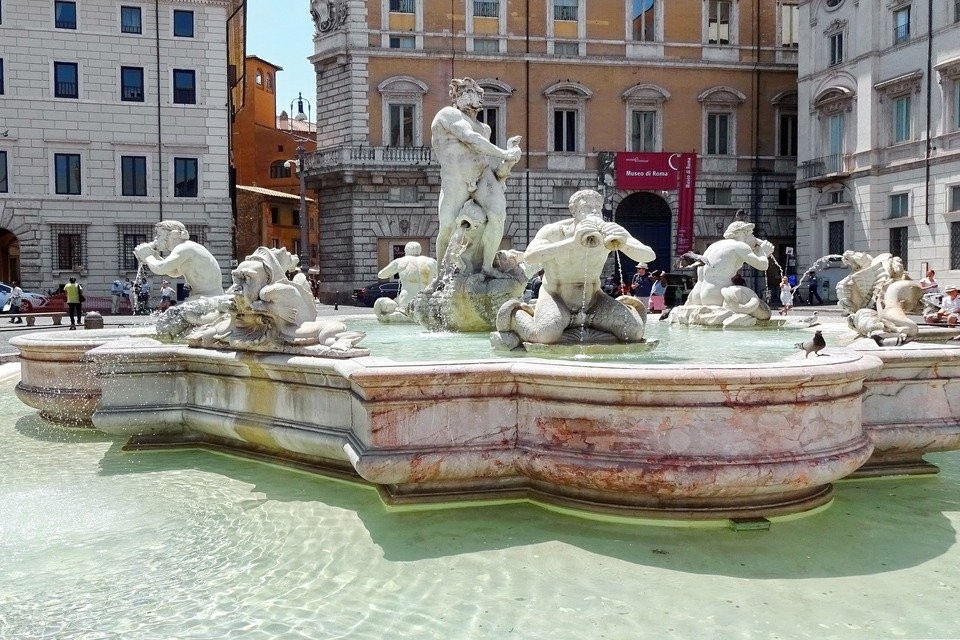
On the southern end lies the equally captivating Fountain of the Moor. This fountain was also first designed by Giacomo della Porta, with a simple layout that was later enriched by the addition of a central figure designed by Bernini. The sculpture depicts a robust African man, known as the Moor, engaged in a struggle with a dolphin, surrounded by four Tritons blowing conch shells. The movement and playful strength of this fountain, along with its harmonious proportions, contribute to the lively atmosphere of Piazza Navona.
At the southern end of Piazza Navona stands the Fountain of the Moor, a magnificent work of art that adds character and symbolic depth to the square. Like its counterpart, the Fountain of Neptune, this fountain was originally designed by Giacomo della Porta in 1575, during the late Renaissance period, as part of a larger project to provide the piazza with elegant water features. Initially, the fountain featured a large basin and decorative elements but lacked the dynamic central sculpture that defines it today.
The fountain's transformation came in the mid-17th century when Pope Innocent X — the same pope who commissioned Bernini’s celebrated Fountain of the Four Rivers — decided to enrich the square further. Gian Lorenzo Bernini, Rome’s greatest Baroque sculptor and architect, was called upon to enhance the fountain. His design introduced the striking central figure of an African man, known as the "Moor," wrestling with a dolphin in a dramatic struggle, surrounded by four Tritons. Although Bernini only provided the model, the final sculpture was executed by artist Giovan Antonio Mari in 1654, following Bernini’s vision.
The choice of depicting a Moor — a term historically used to describe North African people — reflects the fascination with exoticism and distant lands common in Baroque art, as well as the desire to represent the far reaches of the world and the vastness of Roman influence. The Moor’s expressive posture, caught in mid-motion, captures the theatrical energy and grandeur typical of Bernini’s style, while the swirling water adds to the sensation of liveliness and drama.
Surrounding the central figure, the original dolphins, masks, and Tritons by della Porta remain in place, perfectly blending Renaissance balance with Baroque exuberance. The fountain’s intricate combination of human strength, marine mythology, and playful water displays contribute to the festive and artistic identity of Piazza Navona.
How to Get to Piazza Navona
Reaching Piazza Navona is both simple and enjoyable, thanks to its prime position in the heart of Rome’s historic center. While there is no direct metro stop at the piazza itself, several bus lines conveniently stop nearby, particularly along Corso Vittorio Emanuele II or at Largo di Torre Argentina. From these stops, it’s just a short and pleasant walk through some of Rome’s most charming and picturesque streets. Many visitors also choose to arrive on foot, strolling from nearby attractions like the Pantheon, the Spanish Steps, or the vibrant Campo de’ Fiori, making the journey as memorable as the destination itself.
If you’re starting from the famous Trevi Fountain, Piazza Navona is just about 1 kilometer away. This translates into an easy 10 to 15-minute walk, weaving through narrow cobblestone lanes filled with boutique shops, hidden churches, and small cafés where you can pause for a coffee or a quick gelato. Along the way, you’ll pass by elegant Renaissance and Baroque façades and may even stumble upon lesser-known piazzas that capture the timeless charm of Rome. The route itself becomes part of the adventure — an immersive experience in the city’s layered history and atmosphere.
Reaching Piazza Navona from the Pantheon is equally simple and delightful. The distance is around 500 meters, making it just a short 5 to 7-minute walk. From the Pantheon, head towards Piazza della Rotonda and follow Via Giustiniani until you reach Piazza Sant’Eustachio. Continue along Via della Dogana Vecchia, and soon you’ll find yourself walking into the magnificent space of Piazza Navona. Along the way, you’ll be surrounded by stunning architectural details and glimpses of hidden courtyards, offering a true Roman atmosphere that makes every step enjoyable.
No matter how you get there, whether by bus, on foot, or by taxi, arriving at Piazza Navona feels like stepping into a grand open-air stage. Its central location makes it a perfect starting point or stopping point while exploring the Eternal City, and its beauty is always worth the journey.
How Long to Spend at Piazza Navona
Piazza Navona is not just a square — it’s an open-air museum, a stage for artists, and a living piece of Roman history. While many travelers spend between 30 minutes to an hour strolling around its cobblestones, marveling at the grand fountains, and snapping photos, the piazza rewards those who stay longer. If time allows, sitting at one of the elegant cafés to sip a cappuccino or enjoy a gelato while watching street performers is a must. The atmosphere is lively yet relaxed, making it the perfect place to take a break from sightseeing and let the Eternal City’s charm fully embrace you.
For those with a deeper curiosity, the square offers layers of art, history, and culture. One of the most iconic landmarks is the Church of Sant’Agnese in Agone. Built on the site where Saint Agnes was said to have been martyred, the church stands as a monument to faith and resilience. Its breathtaking façade, designed by Francesco Borromini, faces the spectacular Fountain of the Four Rivers — creating a dramatic dialogue between architecture and sculpture that defines the Baroque spirit of Rome. Stepping inside the church, visitors are greeted by sumptuous decorations, intricate frescoes, and a quiet spiritual ambiance that contrasts with the lively piazza outside.
Lining the square is the grand Palazzo Pamphilj, now home to the Brazilian Embassy. In the 17th century, it was the seat of Pope Innocent X and his family, who transformed the area into a showpiece of power and prestige.
One of the true joys of Piazza Navona is simply wandering and soaking in the scene. The square pulses with life: street artists sketch portraits, musicians fill the air with melodies, and performers entertain visitors of all ages. During the Christmas season, the piazza becomes even more magical. The annual Christmas market is one of the most beloved in Rome, with brightly lit stalls selling traditional sweets like torrone and panettone, handcrafted toys, ornaments, and festive treats. Children delight in puppet shows and carousels, while adults can enjoy mulled wine and soak in the holiday cheer.
Best of all, Piazza Navona is completely free to visit. You can walk through centuries of art and history, admire masterpieces by Bernini and Borromini, and experience the vibrant Roman street life without paying an entrance fee. Whether you’re stopping by for a quick visit or spending an afternoon immersed in its beauty, Piazza Navona is a place where time slows down, and every corner reveals something remarkable.
Our categories:
You may also be interested ...
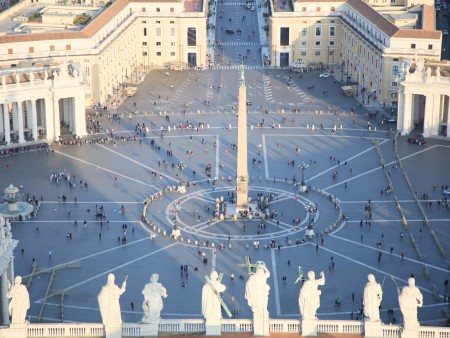
Vatican Private Tour with Sistine Chapel & St. Peter's Basilica: Renaissance’s Wonders
Private tour
Discover with a skip the line Private Vatican Tour the Sistine Chapel, Vatican Museums and St Peter’s Basilica
starting from: € 375
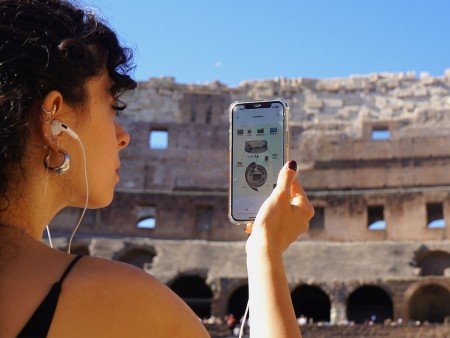
Colosseum Guided Audio Tour with Roman Forum and Palatine Hill
Private tour
Discover Ancient Rome’s secrets and history with our immersive Colosseum guided audio tour, rich in image and content
starting from: € 51 € 42